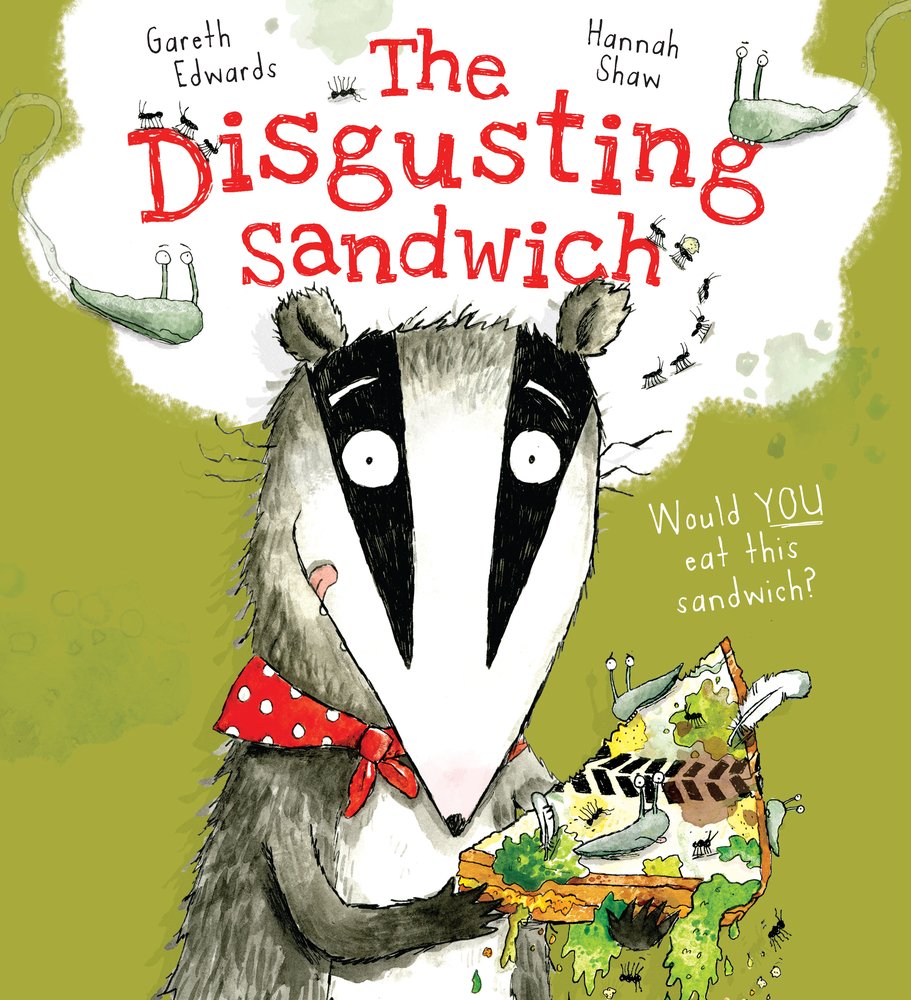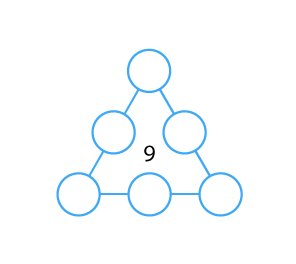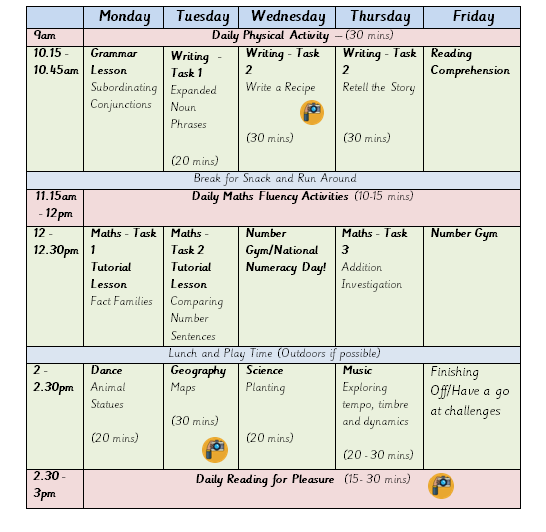Well done everyone for another wonderful week of home learning! We are really enjoying seeing the work on 2BuildaProfile and appreciate all of the time and effort that’s going into the tasks. We hope you and your children enjoyed receiving last week’s profile. Remember that, whilst we love receiving work, there is absolutely no pressure to send in everything! Prioritise submitting the 3 ‘photo opportunities’ and remember health and well being is the top priority.
For Week 4, we have an exciting new key text for writing, number work in maths, and tasks for dance, music, science and geography.
Access to all resources is available here and, as last week, links to specific resources will be available throughout the plans. Here is the suggested timetable:
Reading
Learning objective: Read books aloud that are closely matched to phonics knowledge, sounding out unfamiliar words accurately, automatically, and without undue hesitation.
This week, we are excited to introduce a wonderful new reading resource ‘Bug Club Online’, which will allow you to access high quality reading books online, closely matched to your child’s reading ability. Look out for the email which will give you details of your child’s log in. If you have any problems logging on please contact your class teacher at the usual email address. As you read the book you can look out for bugs on the pages, these link to questions/tasks to help improve comprehension.
Photo opportunity: This week, we would love to see what the children are reading at home. Send us a picture alongside a brief note about what they are reading, if they are enjoying it and how they are getting on.
Comprehension: Following on from our learning of Ramadan last week, try this reading comprehension challenge. As always, pick the challenge level that you think is right for your child.
Grammar
This year we have been working closely with The English Hub at St Peter’s Primary in Portishead. They have produced some fantastic lessons to help Year 2 children refresh their understanding of some key grammar concepts. This week, the lesson is about subordinating conjunctions. You can access it here.
Writing
This week we are working on our new key text ‘The Disgusting sandwich’.

You can hear Mrs Larner read it here.
Try to watch the video through a couple of times to really familiarise yourself with the story and the language. On the second viewing try to think of some actions to go with the story.
Task 1 – Learning Objective: Write expanded noun phrases.
Do you remember what an expanded noun phrase is?
An expanded noun phrase is a phrase made up of a noun and at least one adjective. If one or more adjectives are listed to describe the noun, a comma should be added to separate the sentence. Here is a short video video to help show why they are used.
Today we are going to write some of our own expanded noun phrases to describe ingredients we might put in a disgusting sandwich. Write a list of ingredients using 3 adjectives to describe each noun, i.e.:
- fresh, tasty, white bread;
- brown, squelchy, sticky mud;
- rough, gritty, dirty sand.
You can use the text for inspiration or think up some more disgusting ingredients of your own.
Task 2 – Learning Objective: Write a clear, coherent and well punctuated recipe.
Remember your seed packet writing from last week? This week we are writing more instructions but this time it will be in the form of a recipe… a recipe for a disgusting sandwich! You can use your work from Task 1 to help you decide which ingredients you would like to use. You can use one of the differentiated proformas for instruction writing in the resource folder if you like or write straight into your book, it’s up to you.
Remember these 4 points for writing success:
- Write in the present tense;
- Use imperative verbs (put, spread, mix) or adverbs (slowly, carefully, lightly) to begin each step;
- Use time conjunctions (first, next, lastly);
- Use clear descriptions.
Here is a completed example.
Challenge: Make the disgusting sandwich following your recipe! Send us a photo of it along with your recipe but whatever you do don’t eat it! It’s disgusting!
Task 3 – Learning Objective: Retell a familiar story.
Today you are going to have a go at retelling the story in your own words and in your own style. There are a number of ways you could choose to do this task:
- Drama: Put on a show for your family! Have a go at retelling the story as a play, a puppet show or even an interpretive dance number;
- Draw the story as a comic strip;
- Rewrite the story in your own words. Here is a word mat to support you and some proformas if you would like to use one.
Challenge: Do all three!
Maths
Wednesday – National Numeracy Day!
National Numeracy Day is all about recognising that numbers play a big part in all our lives and helping people sharpen their skills and build their confidence. If you are interested, there are some Numeracy Day activities available to try. These activities would be lovely to try as a family, especially with older siblings.
Lessons 1 and 2 will use instructions from a video tutorial. Please be aware that you will need to click on the ‘Week 3 (w/c 4th May)’ tab to find the correct tutorials. Before commencing the video ensure that your child has everything they need, including:
- the correct ‘Flashback4’ sheet;
- the question worksheet (the answer sheet is also available but please don’t give them this);
- a pencil;
- Some paper to write on (new for this week);
- Number cards if you have them (post-its or pieces of paper are fine if not) – some are saved with the Lesson 1 resources.
The tutorial will ask your child to pause the video at certain points. Please ensure that they know how to do this if you are not able to sit with them.
Daily Fluency: Tasks 1 and 2 will start with a Flashback 4 sheet, although these are not included in the video this week. Three additional fluency tasks are available here. This week, these will focus on applying the inverse rule for addition/subtraction and multiplication/division. Here is a clip to remind children about using the inverse to make matching number facts.
Task 1 – Learning Objective: Reason with and calculate bonds to and within 20, recognising other associated relationships.
Lesson 1 Resources.
Set up the tutorial. Remember to click on the ‘Week 3 (w/c 4th May)’ tab and scroll to ‘Lesson 1, Fact Families Addition and Subtraction Bonds to 20’.
You will need the Flashback4 Fluency Sheet (to be completed before the tutorial), some paper to work on (their school workbook would be ideal) and the worksheet. It may also be useful to have some number cards (or bits of paper). This week, the worksheet is to be completed after the tutorial. Please go through the answers with your child when they have finished.
If your child has difficulty following the tutorial and answering the questions independently, please support them using objects to count with.
Extension: Try the Mastery Challenge cards!
Task 2 – Learning Objective: Use the <, > and = signs to represent the relationship between number sentences. Represent number sentences as a part, part, whole model and a bar model.
Lesson 2 Resources.
We recommend watching this clip about comparison symbols to revise how <, > and = are used before starting the tutorial.
Set up the tutorial. Remember to click on the ‘Week 3 (w/c 4th May)’ tab and scroll to ‘Lesson 2, Compare Number Sentences’.
You will need the Flashback4 Fluency Sheet (to be completed before the tutorial), some paper to work on and the worksheet. This week, the worksheet is to be completed after the tutorial. Please go through the answers with your child when they have finished.
If your child has difficulty following the tutorial and answering the questions independently, please support them using objects to count with.
Extension: Try the Mastery Challenge Cards!
Task 3: Learning Objective: Use reasoning about numbers and relationships to solve problems and their thinking.
Numbers Round Up! Click here!

This is an addition investigation that utilises reasoning skills. Children must put the numbers 1 – 6 in the triangle so each side adds up to the total in the centre. Use the statements and questions on the sheet to support your child’s problem solving skills. Remind them to use objects to count with if they would like.
PE
Fitness: Please continue to start your day with Joe Wicks or something similar. You are aiming for 30 mins with a warm up and cool down.
Skills: Dance
Lesson Objective: Perform dances using simple movement patterns.
You will need some music that you can turn off and on easily and a reasonable amount of clear floor space. It’s more fun with more than one so feel free to join in! For inspiration, you can watch this clip.
Warm up by dancing freestyle to your favourite song. Use your whole body, not just your legs.
We are going to play a game of animal musical statues. Think about how each animal moves and what they look like before you start. Play the music for 1/1.5 minutes each round. Create a dance for each animal by linking three movements together. Include movements on the floor and jumps. When the music stops, hold a pose for 10 secs. Try these animals:
- Chicken (flap your wings, peck at the ground, strut)
- Elephant (be heavy and stomp, have a trunk)
- Frog
- Lion
- Penguin
- Monkey
- Eagle
- Snake
- Crab
- Animal of your choice
As a challenge, can you balance on one leg for one or more of your poses?
For the cool down, please dance in the style of a sloth or a slow motion robot to your favourite song.
Geography
Learning Objective: Devise a simple map and use and construct basic symbols in a key.
Resources here.
Follow the PowerPoint about maps.
Use the template to design your own town. Use the symbols from the example map or design your own. Remember to create a key for your map.

Challenge: Create your own map, maybe of an imaginary town or even your garden. Use symbols to show where things are. Create a key for your map.
Science
Learning Objective: Find out and describe how plants need water, light and a suitable temperature to grow and stay healthy.
Over the next couple of weeks we are going to write a plant diary based on observations of the three different seeds we have been growing. You can write it on the same page as your predictions or begin a new space for it in your book. Put a date each time you add a new observation. Your sentences might look something like this…
Plant A is/is not growing because…
Plant B is/is not growing because…
Plant C is/is not growing because…
Can you add some drawings of your seeds as they change? Can you label these drawings? You might want to add words like: seedling, roots, shoot, seed leaves, root hairs, cotyledons. See the PowerPoint for a refresher about how plants grow.
Music
Learning Objective: Understand and explore how music is created including through tempo, timbre and dynamics.
Play the clip.
Listen carefully with your eyes closed. Can you guess what the choir is imitating? All the music is made using parts of the body. Can you guess how those noises are made?
Watch again to see if you were correct. Why does the music get slower and quieter at the end?
Next, go to through the PowerPoint on Body Percussion.
Finally, watch the clip and perform with the choir. copy their tempo, timbre and dynamics.

